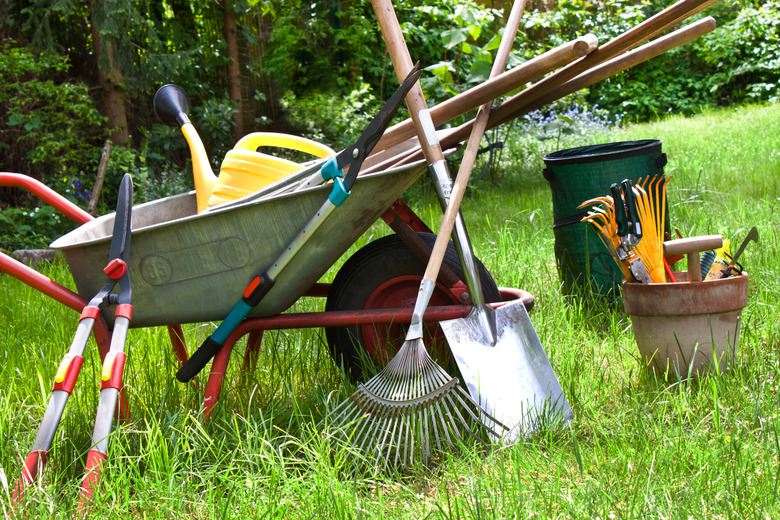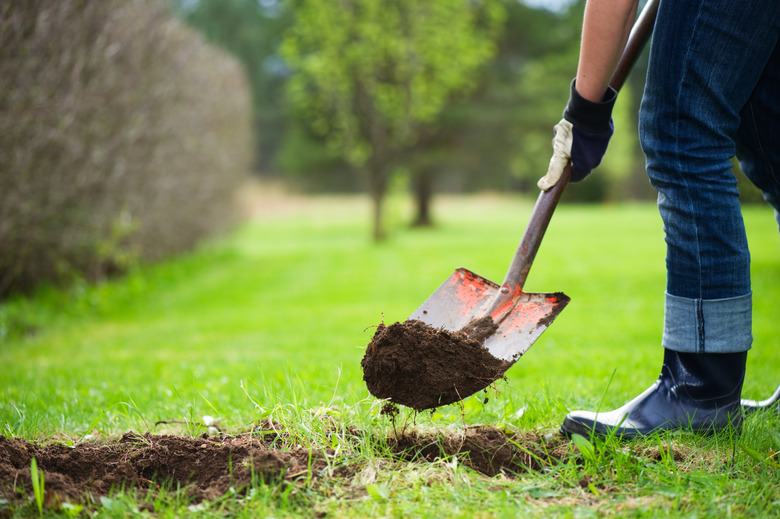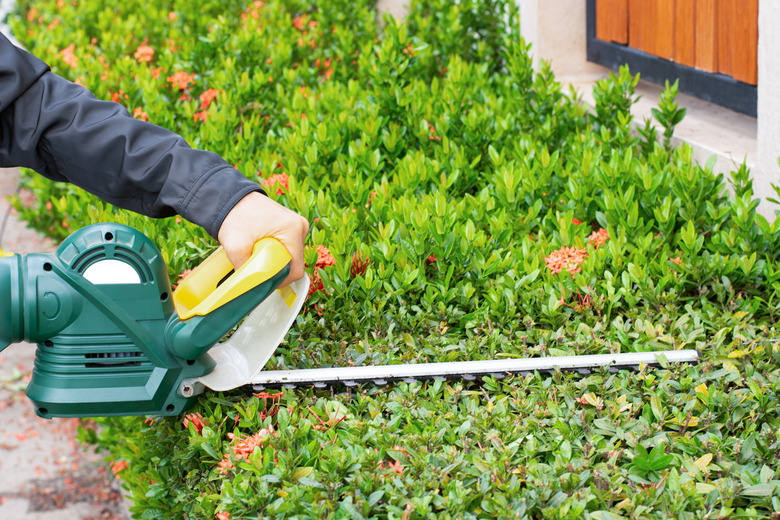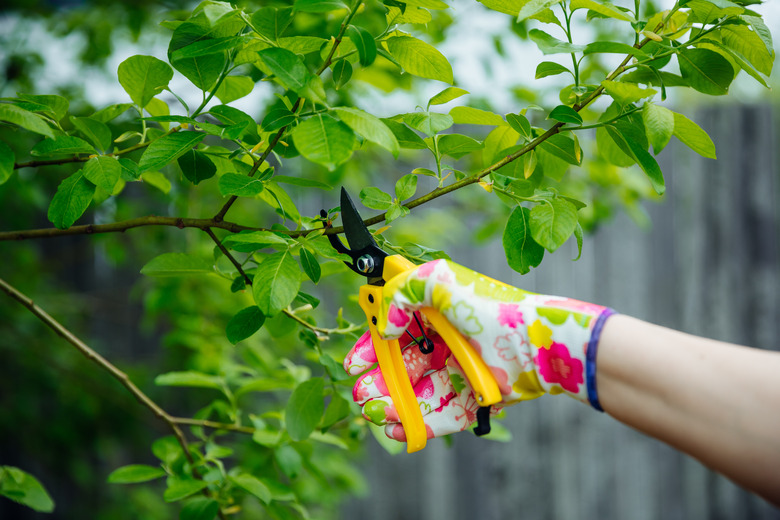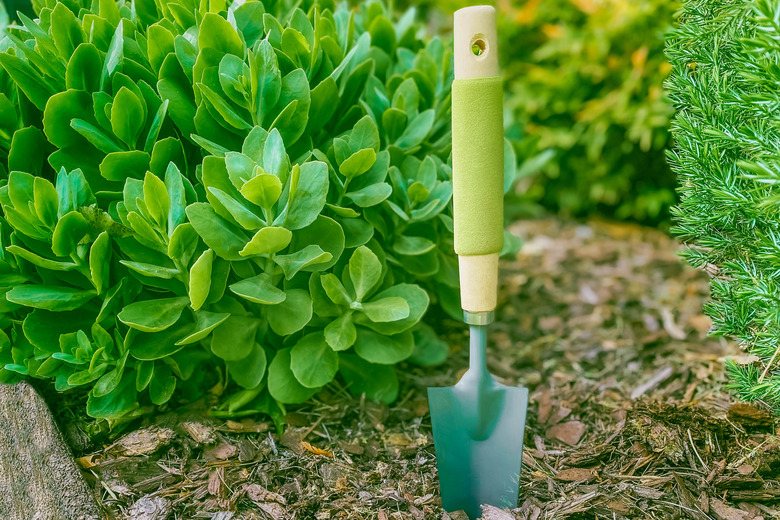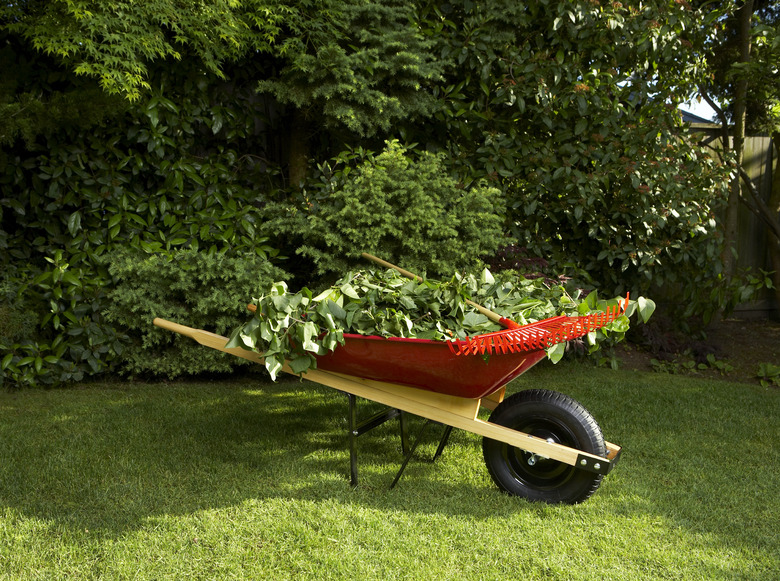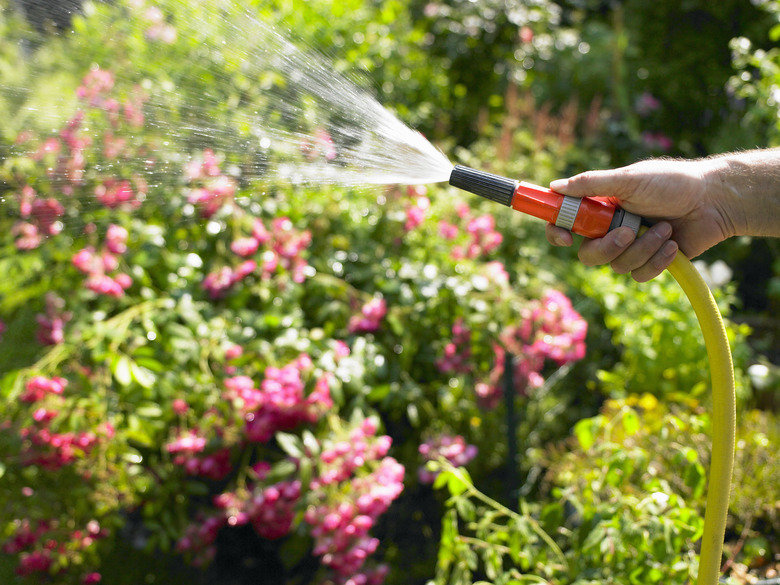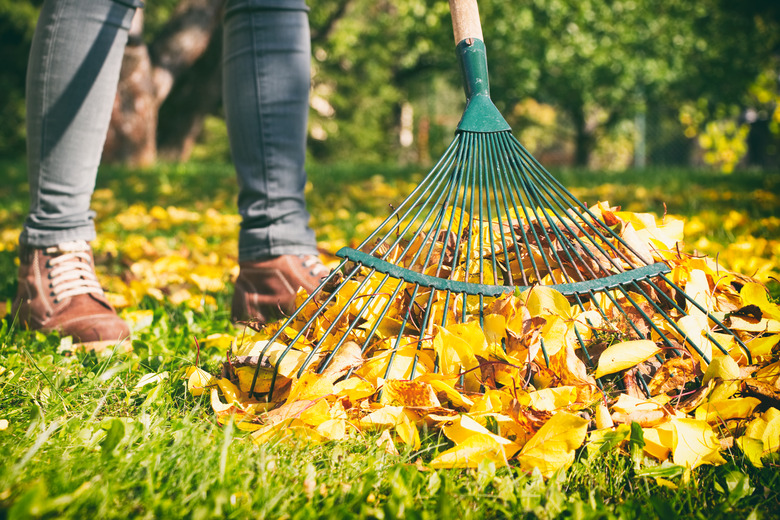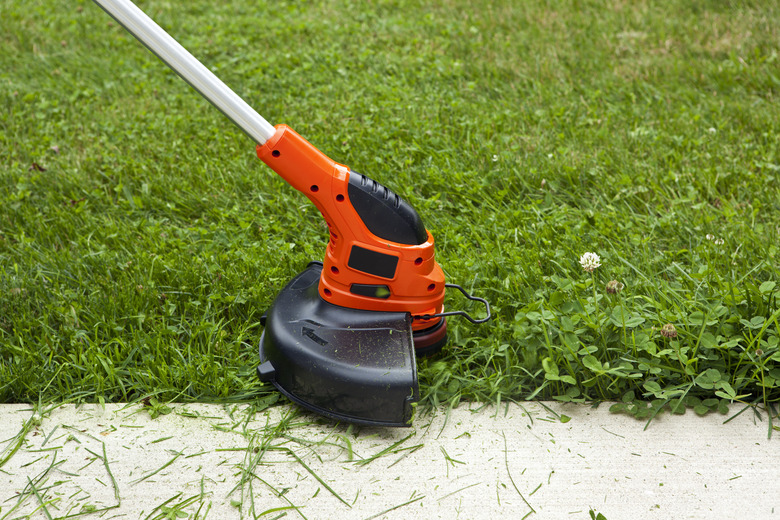The 8 Best DIY Landscaping Tools
We may receive a commission on purchases made from links.
When the landscape design phase is complete and you're ready to start work, you need an array of landscaping tools to turn your property into an oasis of growing flora that is the realization of your vision. Even if you're like most homeowners and aren't starting from scratch, you still need a collection of shovels, rakes, pruners and loppers to keep your landscape and garden looking their best and to hone all that living energy into a harmonious setting that suits your lifestyle.
Most of the landscape tools you should keep in your garden shed are common hand tools that gardeners have used since time immemorial, and their functions aren't mysterious. However, the tools available today are a far cry from the ones in use in the 1800s, and it pays to do a little shopping to get the ones that perform their functions most efficiently and with the least amount of energy expenditure on your part. Speaking of energy, landscape tools that rely on gas or electricity have gotten ever more sophisticated, and a few are practically indispensable mainstays in the landscaper's tool collection.
1. Shovels Are Important Landscaping Tools
1. Shovels Are Important Landscaping Tools
If you're going to do any kind of work in the yard or the garden, you need a shovel. In fact, you need several different types, but if you only have the budget for one, make it a round-point shovel, which is the tool you need to turn over flower beds, dig large holes in which to plant trees and shrubs, maintain the edges of your lawn and transfer dirt, manure, compost and mulch. If your budget allows for only one shovel, purchase one with an easy-to-hold D-handle, such as the Razor-Back digging shovel, with a tempered steel blade that cuts easily through compacted soil.
If budget allows, you should also have a square-point shovel, which is more handy for transferring materials than a round-point shovel, a spade for making cleaner borders around your lawn and garden than a round-point can do and a trench shovel with a long, narrow, pointed blade for installing drains and digging deep holes. Got roots? Woodworking Toolkit recommends the Radius Garden 22011 Root Slayer shovel, which combines a sharp point with a serrated edge so you can saw while you dig.
2. You Can't Cut Without a Saw
2. You Can't Cut Without a Saw
You're going to need several saws, but again, if you're on a budget and can only buy one, make it a foldable pruning saw. It has teeth like those of a carpenters' saw, but they are deep and cut more quickly, and the blade itself is narrow and tapered, so it fits in tight spaces. You'll need this to cut branches larger than about 1 1/2 inches in diameter, and you'll be surprised how often you use it. Many of the top pruning saws are Japanese, and the FUJIWARA folding pruning saw is one of the most affordable.
Add a long pole, and you have a tree pruner, which is often fitted with bypass pruning shears so you can trim high branches of all sizes from the ground. Fiskars is a top brand name when it comes to pole saws and other cutting tools, and the Fiskars PowerLever with a 14-foot fiberglass pole is one of the best values on the market. Add some battery power with a RYOBI 18V pole saw, which is basically a small chain saw on a stick, and you can handle larger jobs with less effort.
Speaking of chain saws, it isn't a bad idea to have one in your tool collection, and believe it or not, you can now find battery-powered ones that rival gasoline-powered ones for usefulness around the house. You wouldn't use a saw such as the Makita 18-volt chain saw to fell a large tree, but this tool will hold its own when you are clearing wood and cutting midsize branches.
3. Pruners Control Growth and Remove Dead Wood
3. Pruners Control Growth and Remove Dead Wood
Garden Design puts pruning shears at the top of the list of necessary landscaping tools because plants need occasional pruning to prevent them from taking over, and it is necessary to keep them healthy. Pruning shears, or secateurs, come in two varieties: bypass pruners, which are best for cutting live wood, and anvil pruners for dead wood. If you purchase only one, make it a bypass pruner because, as Garden Myths points out, anvil pruners can crush live branches and damage them.
Loppers are basically pruning shears with long handles, and they are also essential landscaping tools because the extra leverage allows them to do jobs that pruning shears can't do. Hand pruners can do the delicate job of cutting back small branches to stimulate plant growth, but reach for loppers when you need to cut off a branch at the base or to cut vegetation that's out of reach when using your hand pruners. Both bypass and anvil loppers are available, and as with pruning shears, bypass loppers are preferable if you plan on adding only one set to your collection of landscaping tools.
4. Every Gardener Needs a Hand Trowel
4. Every Gardener Needs a Hand Trowel
Gardeners may consider pruners the number one gardening tool, but Gardening Know How considers a hand trowel equally important. No shovel is delicate enough for planting bulbs and seedlings, and when you head to the garden to pull out weeds, your trowel is the garden tool you'll want to bring with you.
A good trowel has a rust-proof blade made of stainless steel or composite material. It's sharp and narrow and has a rounded or V-shaped trough to hold dirt. If you like folding tools that fit easily in your tool belt, the SE stainless steel mini folding trowel is the best choice. The Fiskars 79796931J fiber composite transplanter doesn't fold, but like most quality trowels, it has gradations on the blade for measuring planting depth.
5. Use a Wheelbarrow and Save Your Back
5. Use a Wheelbarrow and Save Your Back
Wheelbarrows have probably been around as long as the wheel, but compared to those of our ancestors, today's models are more lightweight, durable and maneuverable. You'll need one for transporting dirt, mulch, sand, seedlings and a host of other materials, and you may use it for other purposes, such as mixing concrete. Today's plastic wheelbarrows are as durable as the metal wheelbarrows of yore, and they won't corrode.
The True Temper poly wheelbarrow with dual wheels is practically tip-proof, but it will navigate a narrow pathway as easily as one with a single wheel. For leaves and other lightweight materials, you might consider a garden cart or a lawn cart.
6. You Need a Hose to Water by Hand
6. You Need a Hose to Water by Hand
Even if you install a sprinkler system (or a far more efficient drip system), you'll inevitably have to hand-water parts of the lawn and garden. You need a garden hose, and a hose needs a water wand or a nozzle. Watering without a nozzle that can adjust the spray pattern from jet to shower to mist is a spectacular waste of water.
A good garden hose is lightweight, kink-proof and easy to store when you aren't using it. Expandable hoses are a fairly recent development, but be careful because even though less expensive ones may be compact, they have a narrow passageway that can limit water flow. Popular Mechanics recommends the Flexi Hose, which reaches a maximum length of 50 feet and comes with an eight-function nozzle. If you opt for a nonexpandable hose, the Perfect Garden Hose by Tuff-Guard, which is kink-proof and capable of delivering 500 gallons per minute, is your best bet.
7. Get a Garden Rake and a Leaf Rake
7. Get a Garden Rake and a Leaf Rake
A garden rake and a leaf rake are two very different tools, and you need both of them. You'll use the garden rake to move dirt around in garden beds, to spread mulch and to work in manure and fertilizer. The leaf rake is the one you need for raking leaves and grass clippings off your lawn, so instead of spiked metal tines that can dig, it has flexible ones that allow the rake to ride over large piles of material.
Garden rakes haven't changed much over the years, and the one your grandfather used will probably work well for you too. If you're buying a new one, choose one with a lightweight fiberglass handle and a bowed head, which makes it easier to drag material through the dirt. The Bully Tools 16-inch steel head bow rake is an economical choice, but don't leave it in the sun because fiberglass can crack.
Leaf rakes have undergone more of an evolution, and whereas the tines of earlier ones were made of metal, contemporary ones are more likely to have resin tongs. A wider rake covers more area, but that can be a disadvantage because extra material can be harder to drag across the lawn. The Fiskars leaf rake, rated the number-one rake by Business Insider, has a wide spread, but the tines are arranged in a square arrangement and don't splay out, which makes the rake more stable overall.
8. Essential Power Landscaping Tools
8. Essential Power Landscaping Tools
Pressure washers, augers, tillers and cultivators are essential when you need them, but that isn't very often, and you can usually rent them. One power tool, however, qualifies as essential and should be in every tool shed, and that's a string trimmer. Battery technology has advanced to the point that a battery-powered trimmer can do everything a gas-powered one can, and if you choose a model with attachments, it can double as an edger and even a mower. Many people with small lawns use trimmers to maintain the grass instead of lawn mowers.
When it comes to standalone trimmers, DEWALT makes one that is highly regarded by such reviewers as the All Electric Lawn, but its 20-volt battery is underpowered compared to the 40-volt RYOBI string trimmer, and besides being longer lasting and more suitable for heavy-duty work, the RYOBI trimmer is attachment capable. You can remove the string head and install attachments for edging or cutting.
A string trimmer isn't a great lawn care tool if you have a large lawn. You'll probably want to include a lawn mower among your landscaping tools, and whether you choose a riding mower, a rotary one or a push mower depends on the size of the lawn, the topography and your budget and preferences.
People with large properties also need other power tools, including leaf blowers and hedge trimmers for maintenance and power diggers (which are common rental tools) for installing fences and other hardscape features. These people are more likely to hire a landscaper who already has all the necessary tools than to do the work themselves, though.
